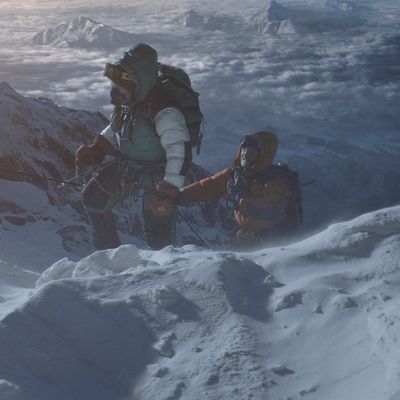
Baltasar Korm├íkurÔÇÖs Everest is not the majestic mountaineering epic you might have expected. Despite the IMAX 3-D promotional gloss, this is a movie that gets down to eye level with its characters ÔÇö a movie not of expanse but of close-quarters despair. Even when people plummet to their deaths, the film treats it quietly, modestly; the horror is in the no-big-deal-ness. As such, Everest may disappoint those looking for a more awe-inspiring film with big vistas and jaw-dropping stunts and acts of surreal heroism. Unlike many mountain-disaster stories, this is the kind that makes you never want to look at a mountain again.
Everest recounts the true-life tragedy in 1996, when a deadly blizzard and other mishaps led to what was then the deadliest day in Mt. EverestÔÇÖs history. Numerous books and articles have retold the story, including Jon KrakauerÔÇÖs best-seller Into Thin Air. Those who know the events well ÔÇö and who remember the specific fates of the climbers involved ÔÇö may have a different response to the action of the film than those coming to it with little advance knowledge. The initiated may feel like theyÔÇÖre watching a sad, deliberate march toward the inevitable; for others, it may feel more like an adventure story gone horribly, horribly tragic.
Actually, we have a term for those. Everest feels more like a disaster movie than anything else. And, true to that genre, this isnÔÇÖt about one or two guys trying to make it against the odds (as with Korm├íkurÔÇÖs wonderful 2012 film, The Deep), but rather a whole group of people from different walks of life, each dealing in his or her own way with a situation spiraling from bad to worse. So, we start off with some conventional introductions: ThereÔÇÖs Rob Hall (Jason Clarke), the dedicated and ambitious entrepreneur who turned helping ordinary climbers scale Everest into a cottage industry with his company Adventure Consultants; thereÔÇÖs Scott Fischer (Jake Gyllenhaal), the stereotypically laid-back American (and HallÔÇÖs friendly competitor), whom we first see soaking up some sun at base camp; thereÔÇÖs Beck Weathers (Josh Brolin), the brash, gung-ho Texan with a Dole for President T-shirt; and Doug Hansen (John Hawkes), the mild-mannered mailman whoÔÇÖs climbing to inspire elementary-school kids back home.
ThatÔÇÖs just part of the dramatis personae. We also get RobÔÇÖs wife, Jan Arnold (Keira Knightley), who would ordinarily be climbing with him, but is now pregnant and stuck back home; and BeckÔÇÖs wife, Peach (Robin Wright), whose initial coolness toward her husband seems almost cruel. Then thereÔÇÖs Krakauer himself (played by House of CardsÔÇÖ Michael Kelly), who has come to write a magazine piece on Adventure Consultants. The promotional value of that article gives additional impetus for Hall to soldier on with the climb, even though the weather forecast seems increasingly dire.
Then, of course, thereÔÇÖs the mountain itself. Throughout, Everest is treated as both another character and an existential fact, and the dialogue captures the foolhardy, romantic fatalism of those who brave the elements for sport. ÔÇ£The mountain makes its own weather,ÔÇØ weÔÇÖre told. And: ÔÇ£The last word always belongs to the mountain.ÔÇØ Also: ÔÇ£We donÔÇÖt need competition between people! There is competition between us and the mountain!ÔÇØ In fact, that the mountain will always win is a constant. As the climbers go farther up, weÔÇÖre told, theyÔÇÖre literally dying, because ÔÇ£human bodies werenÔÇÖt meant to exist at the cruising altitude of a 747.ÔÇØ Even before the true chaos starts, these men and women are already starting to fall apart ÔÇö moving, thinking, and talking slower. This isnÔÇÖt a journey of heroism; itÔÇÖs a journey of faster and faster decay.
Korm├íkur has a tough task here, juggling an impressive number of characters at different stages of the climb. Compounding the difficulty is the fact that the film has to struggle with the elements almost as much as the people onscreen: ItÔÇÖs often hard to see the climbersÔÇÖ faces, and we have to make out who is who based on the color of their outfits. Korm├íkur shot in authentic locations ÔÇö both in and around Everest, as well as the Italian Alps and Iceland ÔÇö dragging his actors and crew to some of the most remote places on Earth. But he hasnÔÇÖt turned that search for authenticity into a fetish: The setting bears down on the performers and the characters, and when the director shows us a vast expanse, or a deadly cliff, or an eerily approaching storm, he always does it in context, making sure to keep the actors in the frame. In his hands, Everest becomes a film of intimate menace.


